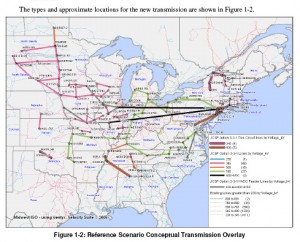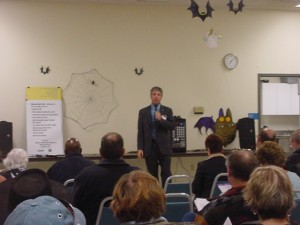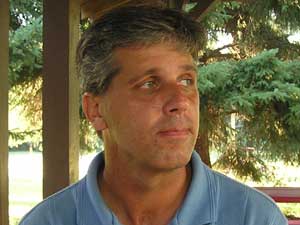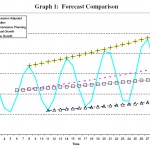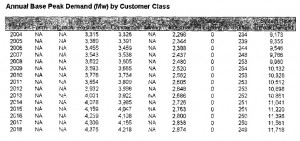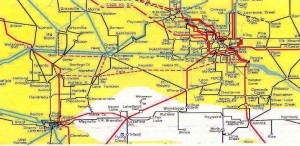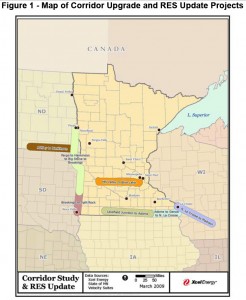DUH… eastern states don’t want our transmission
March 5th, 2010
Repeat after me… EASTERN STATES DON’T WANT OUR MIDWEST TRANSMISSION.
Once more with feeling… EASTERN STATES DON’T WANT OUR MIDWEST TRANSMISSION!!!
And they don’t give a rodent’s rump what we do with our transmission but THEY DO NOT WANT TO PAY FOR IT!
It’s not anything new, but it seems that the message is getting through all the way to Iowa. Soon Minnesota? The message? That the east coast does not want Midwest transmission, that they have their own renewables and not only that, they know that transmission from the Midwest means coal and, most importantly, THEY WILL NOT PAY FOR TRANSMISSION FOISTED UPON THEM.
The 7th Circuit case tossing out PJM’s cost apportionment scheme must be having an impact because everyone is freakin’ about cost allocation. Again, GOOD! The court said that PJM could not shove the costs of transmission on those who do not benefit from it:
Enter the Coalition for Fair Transmission Policy, just launched today with a press conference in Washington, D.C.
Dig this from their site:
HA! I love it when that happens…
Here’s some background on our Midwest Transmission — transmission we don’t need and they don’t want:
This opposition to Midwest transmission is nothing new, I’ve entered documentation in the record in a couple of proceedings now, but what is new is that as of today’s “launch,” there’s now an industry group advocating against Midwest transmission, and that’s one utility interest I’m glad to see hopping mad as hell and not going to take it anymore! GOOD! Maybe that will help stop this stupid transmission-fest across the Midwest.
PUC Chair David Boyd had it right when he testified before Minnesota’s Legislative Energy Commission and led off with, “We need a business plan.” Yes, that’s true, there is no business plan, and there is no MARKET for transmission. I just hope that message gets through before “we” build and WE have to pay for all these wires in the air!
Here are a few recent posts of mine on this, followed by today’s article in the Des Moines Register.
And today’s Des Moines Register article:
By DAN PILLER • dpiller@dmreg.com • March 5, 2010
Alliant Energy has its objections
But as wind energy becomes bigger and more corporate, the utility industry is divided even in Iowa.
Other states have their own plans
While Iowa has speckled its countryside with wind turbines, other states have similar aspirations.
Atlantic seaboard states advanced plans for offshore wind farms, which they say would eliminate the need to ship wind-generated electricity from Iowa.
Read the rest of this entry »
Last night in Mazeppa
October 28th, 2009
Last night, Rep. Steve Drazkowski and Rep. Tim Kelly (who wasn’t there!) hosted a meeting about CapX 2o2o.
But Rep. Randy Demmer, 29A was.
As one person said, he had a “deer in the headlights” look as he sat in the front of the room. Did he have any idea what he’d be in for? I’d talked with him a bit when he came in, and he said he hadn’t heard from many constituents about CapX… oh… OK, well, we can do something about that! And it’s good he showed up to find out what was going on and hear the word on the streets and in the fields.
Short version of the meeting:
- Bill Glahn gets roasted for MOES “Minnesota_Resource_Assessment” report, which is utter crap, the report, that is… the roasting was well-deserved.
- PUC, Commerce, and DOT show up en mass and toady for process and project.
- Rep. Drazkowski utters words of placation, but did not promote Nov. 4 joint committee hearing on repeal of Minn. Stat. 117.19. HE’S ON ONE OF THE COMMITTEES, EARTH TO MARS!!!
- Affected landowners don’t buy it, they get that fundamentally CapX 2020 is not needed and are pissed-off at the crap (see above).
- CapX said they were not going through or around Rochester.
There were two things I let slide, can’t take on everything:
1.Their statements about Big Stone were odd, theywell knows that Big Stone could not interconnect without CapX, and I have the electrical studies which prove it, which after trying 5 times to make it work with a line to nowhere (Granite Falls) then assumed CapX in try #6… But I also wonder whether CapX Brookings (hence all of CapX) can go forward without Big Stone.
2. They kept saying “this is all about local load” and denying the LaX to Mad line, and kept talking about Rochester as the driver, yet they did not note, of course, the new gas plant at West Side sub or the four 161kV lines that are planned.
Overland’s Scorecard (concept stolen from Deb!):
CapX: 0
PUC: -5
DOT: 1
Commerce: -4
The People: +1
Longer version, bigger photo:
The people did a good job of expressing their displeasure and disbelief.
Bill Glahn brought up the Minnesota Resource Assessment Survey! Bad move… He got one of my awards for that Minnesota Resource Assessment Survey, and here’s Maccabee – Presentation to LEC 10/23/09 , another voice saying it’s outrageous. Last night Alan Muller got him good about it, told him” it was an unsatisfactory report, basically just a regurgitation of the business plans of MN… no independent thinking and not in the interests of the citizens of Minnesota …” Alan does have a way with words. When asked for a response Glahn looked abashed and admitted that he knows many people are unhappy with it. AS WELL HE SHOULD! I mean really… to use as an example that phony “chart” of Steve Rakow’s on p. 6:
… with no ID of meaning of X or Y axis, it’s deceitful, but they pulled that in CapX when faced with decreased demand, entering this chart, then citing its entry in the CapX 2020 Certificate of need record as if it means something. Oh, pleeeeeeeeze… We’re way below the 2004 actuals, and this forecast, for the Blue Lake expansion, it’s CapX 2020 era forecasts, we’re about 1,500MW down and growing, down 15% so far, down 2.5% in 1&2Q 2009, SEC 3Q filing and investor call due any second now will take it down further:
After last night’s meeting, Bill Glahn is certainly under fire, but I also got the feeling due to the cadre of state employees stumping for CapX, that it’s their perception that it’s in trouble. It could be something as simple as they have no financing to do it, that demand is so far down that it makes no sense even to PUC and applicants to build it, or … The DOT was distancing itself, there’s been a lot of pressure on DOT. The DOT has its “Policy of Accomodation” (at issue in Chisago Transmission Project III, or IV, the last round, where Xcel stuck poles, BIG poles, right in the middle of the new plan for US Hwy. 8, in one example, right next to and over a business), and here it is:
…and I don’t think they’re going to change that anytime soon. At the Legislative Energy Commission meeting in September, there was mention of an October 13 meeting with the DOT, but Dave Sykora, DOT, mentioned that was cancelled, and instead they met last week. There were no specifics disclosed, but the feeling I got from what was said was that it didn’t go the way legislators wanted it to, DOT didn’t cave. Legislators are looking, from Rep. Drazkowski’s statements last night, and from Rep. Westrom’s comments at the LEC meeting, for a way to do the project with minimal landowner pain. I don’t think that’s doable, and it’s sure not desirable. CapX 2020 is a project that shouldn’t be built, and if it is, it will cause considerable pain, for landowners, applicants and legislators!
Also noteworthy last night was the general failure to accept “need” and a high level of understanding, and for the most part, people are getting the broader picture. (there was an odd comment by Burl Haar that if there were questions about the appeal of the CapX decision, that they post most things on the docket, and to check with him!). So is the PUC’s argument that this belongs at the District Court, and not the Appellate Court (despite what Cupit says) on display in the docket for the world to see? I doubt it, but I’ll check.
Last night, Drazkowski kept referring to efforts to alter the eminent domain law, but he was evasive and didn’t disclose important info, like the upcoming November 4 hearing before Energy & Civil Justice (he’s on Civil Justice!) (Upcoming hearing on repeal of eminent domain exemptions), and he didn’t advise on how to advocate for change, dropped the ball, wouldn’t even pick it up.
Here’s the info on the hearing:
WEDNESDAY, November 4, 2009
10:00 AM
Joint Meeting of the Energy Finance & Policy Division and Civil Justice Committee
Room: 5 State Office Building
Chairs: Rep. Bill Hilty, Rep. Joe Mullery
Agenda: Informational hearing on HF1182 (Bly) Public service corporation exemptions repealed.
Anyone wishing to testify should contact Andy Pomroy at andy.pomroy [at] house.mn
Last night’s meeting in Mazeppa on CapX 2020 follows on the heels of one last Monday night in Chisago, about an 855MW gas plant proposed by LS Power, the Sunrise River Energy Station. Click here for Report on Monday Chisago meeting. They’ve proposed at least three gas plants before at that site, and they didn’t go far, this is the biggest, and most public, and will need mega transmission, BUT LS Power’s Blake Wheatley admitted at the Chisago meeting that they don’t have a plan, don’t have a PPA, don’t have anything but a tax exemption (est. $9-10 million) from legislators who should have known better than to sell out their constituents for nothing, and then after being caught, for a very small “Host Fee.” At that meeting, Mike Bull said Xcel won’t need any power for a long time, 2016-2017 (and if he’ll admit that at long last, we know it’s really a lot further out). As with last night’s meeting, at the Chisago meeting there was, despite heavy lobbying and presence of unions like IBEW and Building & Trades, a clear understanding that the LS Power plant is not needed, and that peak demand is down. Granted LS Power made the mistake of walking into an energy educated community, but even Bob Cupit was surpirsed by the turnout, said he’d never seen such a large crowd, ~500, standing room only in a hockey rink sized room (Also, FYI, Bob stated to the audience that “If citizens feel the system still failed to consider issues, the decision of the PUC can be appealed to the state Court of Appeals.“)
There is a theme. Minnesota doesn’t need more transmission, and we won’t, in the words of Xcel’s Mikey Bull, need an generation anytime soon. Am I paraphrasing correctly, Mike? (Duck & cover — the You Tube of that is forthcoming!!!) The MOES Minnesota_Resource_Assessment is a crock.
Here are the LEC members — it’d be good to contact all of them, and let them know what you think about “need” for generation and transmission, decreasing demand, and CapX 2020 in particular:
http://www.commissions.leg.state.mn.us/lec/members.htm
Here’s Senate member info:
http://www.senate.leg.state.mn.us/members/index.php?ls=#header
Here’s House member info:
http://www.house.leg.state.mn.us/members/hmem.asp
And about CapX and eminent domain, contact:
rep.steve.drazkowski [at] house.mn
rep.tim.kelly [at] house.mn
rep. randy.demmer [at] house.mn
Once more with feeling — Get thee to the House Energy and Judiciary Committee meeting:
WEDNESDAY, November 4, 2009
10:00 AM
Joint Meeting of the Energy Finance & Policy Division and Civil Justice Committee
Room: 5 State Office Building
Chairs: Rep. Bill Hilty, Rep. Joe Mullery
Agenda: Informational hearing on HF1182 (Bly) Public service corporation exemptions repealed.
WOW’s deal with the devil at issue
August 18th, 2009
“Wind on the Wires” and AWEA are whining and crying in the press about unfair treatment to wind generators. They do a deal with the devil to promote transmission and now are getting screwed — sorry, I won’t be hosting a pity party here!
AWEA and WOW’s FERC filing to protest MISO cost allocation proposal
To look at the full FERC docket, GO HERE TO FERC SEARCH PAGE, and search for docket ER09-1431.
“Wind on the Wires” is a subset of the Izaak Walton League – Midwest, not a separate organization. Some background here:
Years ago, the Midwest Izaak Walton League, together with MCEA, ME3 (Fresh Energy) and North American Water Office, did a deal with Xcel, and a massive “Wind on the Wires” grant was announced a couple of days later. The deal was to support a massive transmission buildout, specifically, to work to change state and federal law; to support transmission projects; to usher them through the legislature, state and federal administrative venues, to support at industry transmission planning groups; to support changes in rate recovery; to support changes in transmission need and siting criteria; and to allow transmission-only companies, all the things that Xcel wanted to roll out CapX 2020, JCSP, and whatever else is in their dreams.
Really… it’s all here:
$8.1 Million Wind on Wires grant from McKnight/Energy Foundation
This 2003 Settlement Agreement was in the Minnesota PUC’s TRANSLink docket, where Xcel wanted a transmission only company, not yet allowed in Minnesota. For the docket, go to www.puc.state.mn.us and then click on “eDockets” and search for docket 02-2152. F”or the resulting legislation, some of it, see 2005 Transmission Omnibus Bill from Hell.
So they jump through all those hoops and where are they? What happens?
Back to Cost Allocation of Transmission.
Let’s see… there was one cost allocation scheme, 50-50 split between owner utilities and generators connecting. Otter Tail Power objected and so the utilities changed it to a 90-10 split, and now “Wind on the Wires” and AWEA are screaming, whining and crying saying it has to go back. This has to do with how the utilities characterize the purpose of the line, be it for “Reliability” or “Generation Interconnection” and how costs are apportioned are different. In the CapX proceeding, the “Brookings line” was not declared, and the Fargo and LaCrosse lines were deemed “Reliability” but that’s absurd…
For “Baseline Reliability” projects here’s the cost allocation scheme:
For “Generation Interconnection” here’s the cost allocation scheme:
Ummmmm… a little more background here now that we’re talking about interconnection… does anyone remember the name of that coal plant that Otter Tail Power just got permitted to build? Oh, yeah, right, it’s BIG STONE II. And what was the name of that big honkin’ coal plant that “suddenly decided” to produce electricity rather than syngas? South Heart, yeah, that’s it. See “South Heart coal gasification — Coal on the Wires.” Both plants strategically placed to use CapX 2020 transmission. So what is the impact of this shift to Otter Tail Power and their Big Stone II project?
Here’s the Big Stone electrical link to CapX — it’s all connected:
Here’s new connector ND transmission announced April 3 — it’s all connected:
And of course, the big picture of CapX 2020 – click on it for a bigger picture to really appreciate those lines starting in the Dakotas:
Here’s an article from last week about their objections:
Wind industry protesting plan to pay for new lines
Cost-sharing proposal decried as threat to renewable energy goals
By Leslie Brooks Suzukamo
lsuzukamo@pioneerpress.com
Updated: 08/14/2009 12:01:26 PM CDT
So if “Wind on the Wires” and AWEA object to “generator pays” transmission, where it’s the generator causing the need, then they’re now in essence advocating for a different scheme for Big Stone II and South Heart coal plants too. Oh, good idea…
Here’s another one that turned up — WOW and AWEA sent out a raft of press releasees…
Wind Industry Fights Midwest Transmission Proposal to Stay Alive
by Stacy Feldman – Aug 17th, 2009
Even worse — the plan could put the nation’s renewable energy goals in jeopardy.
Currently, generators and utilities split the price paid, 50-50.
And then there’s the big issue of cost: Who would pay for it?
The MISO proposal is a local version of that long-simmering cost dispute.
FERC has not indicated whether it favors MISO’s proposal or would recommend changes.
The Economist weighs in, now it’s YOUR turn!
May 4th, 2009
I’d wondered why “The Economist” had shown up in my blog stats, and now I know. But from the viewpoint of this article, it’s clear they didn’t do more than scratch the surface of transmission in the Midwest. This is “party line” all the way — I hope they’ll now take the time to read NYISO and ISO-NE’s letter of withdrawal from publication of JCSP!
YOUR TURN! Let them know what you think and why — the registration is instantaneous and easy, so COMMENT AWAY!
Spreading green electricity: A gust of progress
Apr 30th 2009 | CHICAGO
From The Economist print edition
The GALL of GRE’s Kaul!
April 30th, 2009
Will Kaul, VP of GRE, let loose in response to David Morris’ opinion piece a few days ago. What a doozy! How dare he! Talk about out of touch with reality! Maybe he’d better ask a few of the thousands who showed up and commented on this insane series of transmission projects across Minnesota known as CapX 2020.
You can call him and tell him what you think. Will Kaul @ GRE (763) 241-2380!
Will Kaul: Citizens have plenty of input on utilities
The facts on three new power lines came out in dozens of public events.By WILL KAUL
Last update: April 30, 2009 – 11:05 AM
The above quote, “to be a formal intervener, an individual or group simply had to sign up,” is false, and the utmost in arrogance. Kaul … read more sure wasn’t at the CapX proceeding that I was at, and it looks like he hasn’t read the transcript. If he had, he’d know that a couple weeks into the hearing, the judge issued an Order to Show Cause to two intervenors, the Prairie Island Indian Community and United Citizens Action Network to explain why they shouldn’t be booted out! Prairie Island Indian Community said they’d withdraw and maybe intervene in the siting docket. U-CAN, landowners in the route corridor, succinctly told the judge they had every right to be Intervenors, there were no requirements for level of participation, and btw, they were in the middle of condemnation proceedings for the MinnCan pipeline (another of her dockets and recommendations!) and didn’t have resources to do much in CapX. The judge then graciously allowed them to remain in the proceeding. nocapx2020.info/?p=324 Electric use is down, down, hence NoCapX 2020’s Motion to Reopen (November and last month), and soon, Motion for Reconsideration and then appeal. The forecasts are old, 2004-2005, and Xcel admits in its SEC filings that 2007 and 2008 saw declining beaks, SIGNIFICANTLY declining peaks, over 11% in just two years rather than their 2.49% increase, 1.5% increase, or whatever other number was dreamed up for the occasion. Those two years alone push any claimed need for this project way out there in time. And even if there was the “need” that they claim, the physical conductor is way over-spec’d, many many times what’s necessary for even the most generous forecast, and then they have the nerve to upsize it, doubling it, with zero justification! “The PUC upheld the recommendation of the judge…” Of course, they’re supporting MISO’s economic dispatch, rather than ratepayer interests, rather than the public interest. It’s time for a shake-up, not the usual shake-down. Yes, the many pages of transcripts, testimony, exhibits reflect the facts, but the ALJ recommendation and PUC decision do not reflect those facts or the purpose and reality of CapX 2020. From the utility squeals, it’s clear David Morris hit a nerve by being right on target.
An April 24 opinion piece by David Morris (“If it’s citizens vs. utilities, utilities win”) criticized the process state regulators use to review and approve new transmission lines and questioned whether Minnesotans had an opportunity to participate in the recent proceedings concerning three 345-kilovolt lines proposed by CapX2020, a group of 11 utilities.
The piece also made a rather bizarre comparison between sports stadiums and electric transmission lines. Electricity is an essential service that every Minnesotan depends on 24 hours a day, seven days a week.
The state regulatory process encourages public participation. It requires an independent review to ensure that utilities’ plans undergo a thorough and comprehensive vetting.
In the CapX2020 case:
•The Minnesota Department of Commerce held 10 public meetings, and an administrative law judge held 19 public hearings. Any interested citizen could attend and speak.
•To be a formal intervener, an individual or group simply had to sign up.
•The utilities hosted more than 100 public meetings and made more than 150 public presentations about the projects.
Following that extensive review, the Minnesota Public Utilities Commission voted unanimously that the three lines are needed. The decision upheld the recommendation of an administrative law judge, who reviewed thousands of pages of testimony and public comments and conducted seven weeks of evidentiary hearings and three weeks of public hearings.
Among the points the utilities made:
•Since the last major transmission system upgrade in Minnesota 30 years ago, much has changed. Electricity consumption has doubled, as has the number of electricity customers. Communities such as St. Cloud, Alexandria, Rochester and the Twin Cities have experienced significant growth and are facing serious electricity reliability issues.
•Despite today’s economic slowdown, electricity use is projected to continue growing, particularly peak electricity use.
•The transmission system must be designed to withstand the loss of one line by instantaneously transferring power to other lines.
•Minnesota has the most aggressive renewable energy standard in the country, requiring that 25 percent of electricity be from renewable sources by 2025. The Buffalo Ridge in southwestern Minnesota is one of the country’s greatest wind resources. Transmission lines are required to move that energy to customers.
The CapX2020 transmission lines aim to ensure that Minnesota communities continue to enjoy reliable electricity service and that the state’s renewable-energy mandate is met. The regulatory process aims to ensure that citizens have a say in determining whether the lines are needed and where they should be routed.
Will Kaul is vice president of transmission for Great River Energy and is chairman of the CapX2020 organization.
